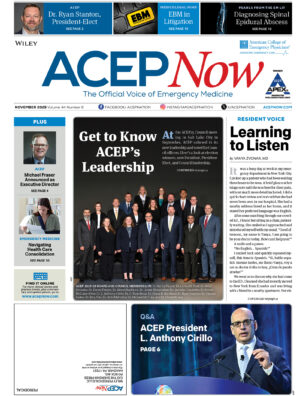
Explore This Issue
ACEP Now: Vol 34 – No 03 – March 2015At ACEP’s 2014 Council Meeting, Resolution 36(14), Development of Telemedicine Policy for Emergency Medicine, was adopted by the Council. This resolution calls for a group of members with expertise in telemedicine to create a telemedicine policy specific to emergency medical practice. “This is an exciting time for telemedicine,” said Hartmut Gross, MD, section chair-elect. “The technology is evolving and poised for rapid growth, which in turn has attracted a lot of new investment in the marketplace. With it, we are solving progressively more common, as well as unique, problems with versatile and creative applications that will soon deliver big-city medicine to small-town America.”
Currently, several academic EM programs and large groups have fully embraced the benefits of telemedicine and have developed innovative solutions for complex emergent clinical problems. The George Washington University Medical Faculty Associates department of emergency medicine, based in Washington, DC, contracts with clients in the maritime industry to provide telemedicine medical support to ships all over the world; The University of Mississippi in Jackson links board-certified emergency physicians with nurses staffing many of the state’s critical access hospitals; the University at Buffalo’s program provides telemedicine services to 51 correctional facilities across New York state; and Avera eEmergency in Sioux Falls, South Dakota, links board-certified emergency physicians and experienced critical care nurses with critical access hospitals, community hospitals, tertiary care centers, and correctional facilities across an eight-state region in the upper Midwest.
In contrast, regulation, coverage, and payment of telemedicine are lagging behind the practice. Issues of liability and other risks, privacy, and medical licensure requirements have not kept pace with technological innovations and applications. The unique challenges and practice environment of emergency medicine make the timely development of a telemedicine policy a top priority for ACEP.
Coverage for telemedicine is provided by some commercial health insurance companies, but only 21 states require that private payers cover telemedicine services, and the definitions also vary by state. Medicare coverage is limited to a small list of Part B (physician) services that are rendered in rural health professional shortage areas or areas approved by the government for telemedicine demonstrations. Any new Medicare coverage requests must be submitted by sponsoring physicians or organizations to the Centers for Medicare & Medicaid Services by Dec. 31 each year. No emergency physician services are covered to date. Medicaid pays for telemedicine services in 46 states and the District of Columbia, but scope of practice, coverage, and payment vary by state.
Recent policy statements from the Federation of State Medical Boards (FSMB) and the American Medical Association (AMA) highlight the urgent need for ACEP to develop its own policy for the use of telemedicine in emergency medicine. The FSMB’s model guideline for appropriate use of telemedicine includes a statement that physicians using telemedicine technology must first establish a physician-patient relationship and be licensed in the state where the patient is located. The AMA also supports policy that requires a face-to-face telehealth consult and also requires the practitioner to be licensed in the state where the patient is located. The nature of emergency medicine’s focus on unscheduled acute care makes it difficult for physicians to first establish a physician-patient relationship. Policies requiring physicians to be individually licensed in the state where the patient is located may also present significant roadblocks and hamper innovation.
An ACEP policy now may avert unintended adverse consequences of other organizations’ future policies. It will hopefully help steer local and national stakeholders with rules and guidelines development, as well as eliminating or modifying restrictive covenants, in this rapidly evolving subspecialty. Creating our own telemedicine policy will additionally broaden awareness of telemedicine among the membership and establish principles for use of technology to create new practice opportunities and provide timely services to patients in more locations.
Ms. Tomar is federal affairs director for ACEP.
Pages: 1 2 | Multi-Page




One Response to “ACEP to Develop Telemedicine Policy for Emergency Medicine”
January 24, 2016
muhammad Irfan HabibI would like to ask about standard operating procedure for telemedicine. I am from Child Life Foundation (NGO) in Pakistan and we are running 2 public sector pediatric Emergency departments Resus Rooms with Telemedicine coverage. Our consultants (qualified fellows in Pediatrics) are consulting on TM and we are improving it through system development, checklist of Medical protocols being followed or not? Another problem we are facing is user acceptability. Kindly Comments.